19/05/2010
More Images on Flickr
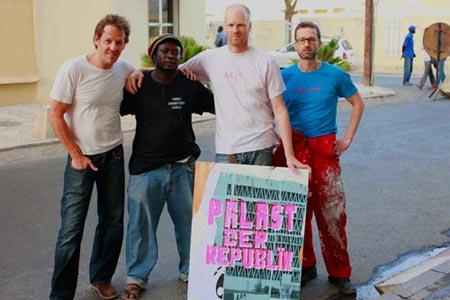
Want to see more impressions from the dakar exposition in Dakar? Click here!
Comments (9)
BASTARD Choose my Identity
Tell me who I am and give me a face. In it you will find facets of me, but also see a reflection of yourself.
The idea behind BASTARD was to bring together photographers, writers, illustrators, graphic designers, musicians and typographers to create a solid and unique book that also functions as a work of art. The profoundly personal impressions of the authors and artists have become intertwined and their distinct and individual visions have served to shed light on our modern culture -- on daily life, on the themes of change and continuity, and on the pervasive branding that is all around us. We must define who we are, be able to form both national and personal identities for ourselves, and in this journey we may come to see that globalization is not a completely negative force. Instead, the trend and phenomenon of globalization offers us proof that we are living in an era as exciting as one could imagine.
What happens when all of the disparate places and faces of the world "shrink" into a global village? What happens when cultures begin to merge and traditions start to dissolve?
Searching to define cultural identity and cultural bastarding, Christian Ernst, Lars Harmsen and André Rösler traveled to various hot spots highlighting the globalization trend. Writers with personal histories of emigration contributed their stories and poems. This book has been published with more than 50 unique typefaces, which have been created by typographers from all over the word. An engaging musical soundtrack is also included, as well as 50 high-resolution images, which serve to visually and aurally complement the book’s ideas.
Fonts: We take a special interest in typography, and have discovered that there are less new fonts designed nowadays, but they still play a big role: sampling, crossing and mixing. They are a form of expression. New fonts have been created by several designers: Peter Brugger, Stefan Claudius, Escobas, René Verkaart, Sirkka Hammer, Martina Hartmann, Sandra Hofacker, Paul Hoppe, David Hubner, Boris Kahl, Matthias Kantereit, Ingo Krepinsky, Heinrich Lischka, Michel M., Thomas Mettendorf, Christoph Rankers, Dan Reynolds, Henry Roussier, Christoph Seiler
All of these fonts are available at volcano-type.de or on the DVD accompanying the book.
DVD: a DVD containing fonts, free pix & illustrations, as well as sound files accompanies the book.
Actar publishes books on architecture, design, photography and art. The most specialized publications are books that take a look at the actions or messages of the artist, architect, photographer or designer from an outside perspective. That which makes Actar a unique publishing house is that the printed product, the book-object, invariably becomes both narrative and visual project in book form. The finished product contains the same information as the actual work, albeit fragmented, and becomes also an integral part of the author’s work. This kind of collaboration between publisher and author can also be seen reflected in the ever-increasing collaboration found between the various branches of design and art: there is architecture in art, photography in architecture and design in photography. This phenomenon has led this publishing house to reappraise the entire realm of visual, formal and cultural production: the ubiquitous production of information continues to dissolve the rigid relationships between creative products, and at the same time continues to dissolve the traditional relationships between producer and recipient.
Ras is a multipurpose space that functions as both gallery and bookstore. It opened in 1998 as Actar’s discussion forum and venue for public presentations. It is also a nodal point for a new generation: to facilitate exchange and interaction. Ras is located near the Museu d’Art Contemporani de Barcelona (MACBA) and the Centre de Cultura Contemporània de Barcelona (CCCB), and is planning to expand to Madrid and Rome during the course of the year.
Actar was founded in 1994 by a group of graphic designers, architects and photographers. Since then it has published over 200 titles, often in collaboration with museums and institutions, including the Museu d’Art Contemporani de Barcelona, arc en reve centre d’architecture, the Baltic Centre for Contemporary Art, the Spanish Ministry of Public Works, the Association of Catalan Architects COAC, the British Council, the City of Barcelona and the Government of Catalonia. Actar has also participated in several joint publications with the Swiss publisher Birkhäuser, and produced the catalogues for the 7th Venice Architecture Biennial: Less Aesthetics More Ethics. Actar’s listings are distributed throughout Europe and Asia by an in-house group of sales agents, and in America by local distribution companies, mainly by Distributed Art Publishers Inc., New York.
Actar today consists of 39 professionals: 5 in-house editors, 7 graphic designers, 4 people who are in charge of the final production; 7 work in the administration and management departments, 2 in press and communications, 3 are in charge of the warehouse; there are also 8 sales agents and 3 people who run the RAS Gallery & Bookstore.
CHRISTIAN ERNST Photographer,
born in Karlsruhe, Germany in 1965
Christian Ernst, inspired by his father, began taking pictures when he was twelve years old. After completing school, he worked for several advertising photographers in Germany, as assistant and partner. For the past ten years, he has been a freelance photographer working for companies all over Europe. Christian Ernst has been involved in many books on
architecture and art. Through his work, he has come in contact with such artists as Lüpertz, Penk, Immendorf, Nietsch and Malakov, to name a few. He was involved in a book project, entitled VERSUS, which he collaborated on with Lars Harmsen and Ulrich Weiß. This book is a good example of the kind of work he has been engaged in for the past few years.
LARS HARMSEN Graphic designer,
born in Hannover, Germany in 1964
Lars Harmsen spent the first four years of his life in Chicago. He then moved to Geneva with his parents for eight years, where he learned to speak French, and then moved to Karlsruhe. He completed his schooling at the French section at the European School. He first studied history and Germanics in Freiburg before beginning to study design at Basel, Boston, Saarbrücken and Pforzheim. He got his degree in graphic design, and in 1996 he founded MAGMA [Büro für Gestaltung] together with Ulrich Weiß. He is the co-founder of STARSHOT GmbH, a design company for sports products, now based in Munich. MAGMA created Type Foundry Volcano-Type.de and the internet forum Slanted.de. In the meantime, Slanted.de has become the most active German typography forum.
ANDRÉ RÖSLER Illustrator,
born in Lahr (Black Forest), Germany in 1970
André Rösler studied design at the Fachhochschule für Gestaltung Pforzheim, and after earning his degree in 1997 Diplom-Designer(FH) he worked there as an assistant. He is co-founder of mal4 - Bürogemeinschaft für Gestaltung in Karlsruhe, and has worked as a freelance illustrator and designer since 1996. In 1999, he became involved in making and directing animation films for Anschi und Karl-Heinz, a children’s television program aired weekly. In 2003, André Rösler illustrated the picture book Kannst du brüllen? published by Peter Hammer publishing house, and in 2005, a children’s book entitled Emil wird sieben. The author of both books was Karin Koch. In 2004, Rösler was awarded the ADC-Preis (Art Directors Club Deutschland) for his illustrations in a book entitled Gutes Benehmen im Galopp.
ULRICH WEISS Graphic designer,
born in Pforzheim, Germany in 1966
Deeply rooted to his region of birth, Ulrich Weiß decided to study design at the art school in Pforzheim, where he met his future partner Lars Harmsen, and earned a degree as in graphic design (Diplom). Before founding MAGMA [Büro für Gestaltung] together with Mr. Harmsen, he worked for several years as creative director for J. G & Partner in Baden-Baden. Last year, Ulrich Weiß collaborated on a typography and photography book, entitled VERSUS, together with Lars Harmsen and Christian Ernst. The book was published by dgv Die Gestalten Verlag in Berlin.
AUTHORS OF THE ROBERT BOSCH STIFTUNG
All the contributors to this book, except Ruediger John, who wrote the introduction, are recipients of the Adelbert-von-Chamisso-Prize which is awarded by the Robert Bosch Foundation. The prize honors books published in the German language by authors who come from non-German-speaking backgrounds. The prize has been presented since 1985. More information on the prize and the foundation can be found on the web:
www.bosch-stiftung.de
LASZLO CSIBA
Born in Mosonmagyaróvár, Hungary in 1949
László Csiba moved to the DDR in 1968 and studied literature from 1988 to 1991 at the Literaturinstitut Leipzig. From 1978 to 1979, he translated several works of Hungarian prose and poetry. Since 1981, he has written various short literary works, short stories and poems in German. He has received many grants, including a grant from the Kultusministerium des Landes Sachsen-Anhalt, the Künstlerhaus Wiepersdorf, the Art Stiftung Plaas, Lindau am Bodensee and the Kuratorium der Stiftung Kulturfonds, Berlin. Csiba was awarded the Adelbert-von-Chamisso-Förderpreis in 1995; in 2000, a grant was awarded Mr. Csiba by the Robert-Bosch-Foundation for his radio play "Ich töte Mozart nicht."
SELECTED PUBLICATIONS: Gleichgewichtsstörung, stories, Tübingen, 1995; Durch das Flugloch der Bleistiftspitze, poems, 1998; Das Lachen der Fische, poems, 2003; ich liebe zu frühstücken, poems, 2004
RADEK KNAPP
Born in Warsaw, Poland in 1964
Radek Knapp grew up with his grandparents in the Polish countryside. In 1976, he moved to Vienna to live with his mother. There, he began to study philosophy and write stories, while working various odd jobs to get by. In 1992, Mr. Knapp was awarded the Nachwuchsstipendium für Literatur awarded by the Bundesministerium für Unterricht und Kunst. In 1993, he won the Würdigungspreis awarded by the city of Vienna, and in 1999/2000 he received a Projektstipendium für Literatur awarded by the BKA. In 1994, he received the Aspekte-Literaturpreis for his pastoral-grotesque tales, entitled Franio, a collection of stories set in the Polish countryside. In 2001, Mr. Knapp was awarded the Adelbert-von-Chamisso-Förderpreis.
SELECTED PUBLICATIONS: Ein Bericht, stories, 1989; Franio, stories, 1996; Herrn Kukas
Empfehlungen, novel, 1999; Papiertiger, Eine Geschichte in fünf Episoden, 2003; Gebrauchsanweisung für Polen, 2005
SUDABEH MOHAFEZ
Born in Teheran, Iran in 1963
Since 1979, Sudabeh Mohafez has been based in Berlin. She has studied music, English literature and pedagogy, and has been a part of several non-governmental organizations
doing work in migration and violence prevention issues. She now lives and works as a freelance author in Germany and Portugal. For the novel Gespräch in Meeresnähe,
Mohafez received a grant awarded by the Berliner Senatsverwaltung für Wissenschaft, Forschung und Kultur, and in 2006, she received the Adelbert-von-Chamisso-Förderpreis for her collection of stories entitled Wüstenhimmel, Sternenland.
SELECTED PUBLICATIONS: Wüstenhimmel, Sternenland, stories 2004; Gespräch in Meeresnähe, novel 2005; Gästezimmer, novel included in: Entwürfe Nr. 43, 2005 www.sudabehmohafez.de
JOSÉ F.A. OLIVER
Born in Hausach (the Black Forest), Germany in 1961
José F.A. Oliver is the child of Andalusian working migrants. He studied Romance languages, Germanics and philosophy at the University Freiburg, and began writing both poetry and short prose texts in German, as well as Spanish at a very early age. From 1988 to 1997, he was awarded several grants. In 1997, he was awarded the Adelbert-von-Chamisso-Preis for all of his literary work to date. In 2001, Oliver was Stadtschreiber (poeta laureatus) for the city of Dresden, and in 2004, he was the Stadtschreiber for Cairo, participating in the midad-project which was organized by the Goethe-Institute. In 2002, he was guest professor and writer-in-residence at the Massachusetts Institute of Technology in Cambridge, USA.
SELECTED PUBLICATIONS: Weil ich dieses Land liebe, poems, 1991; Austernfischer Marinero Vogelfrau, 1997; Fernlautmetz, poems, 2000; nachtrandspuren, poems, 2002; finnischer wintervorrat, poems, 2005.
www.suhrkamp.de
SELIM ÖZDOGAN
Born in Cologne, Germany in 1971
Selim Özdogan is a German author with Turkish roots. He grew up speaking both Turkish and German in Cologne. After earning his Abitur, he studied ethnology, English literature and philosophy without earning a degree. Mr. Özdogan works as a newspaper and magazine writer. His first novel was published in 1995. In 1996, Özdogan was awarded the i>Förderpreis des Landes Nordrhein-Westfalen in the category Young Artist/Poet/Author. In 1999, he received the Adelbert-von-Chamisso-Förderpreis awarded by the Robert Bosch Foundation.
SELECTED PUBLICATIONS: Es ist so einsam im Sattel, seit das Pferd tot ist, novel 1995; Ein gutes Leben ist die beste Rache, stories 1998; Ein Spiel, das die Götter sich leisten, 2002; Trinkgeld vom Schicksal, 2003; Die Tochter des Schmieds, novel 2005
www.selimoezdogan.de
ILIJA MARINOW TROJANOW
Born in Sofia, Bulgaria in 1965
Ilija Trojanow was granted political asylum in Germany in 1971 after his family fled to Italy through Yugoslavia. From 1972, he lived in Kenya for several years, attending a local German school. After earning his Abitur, he studied law and ethnology in Munich and began taking journalistic assignments. In 1998, he moved to Bombay, India and has since then worked mainly as a journalist and translator in that city. In addition to numerous grants, Trojanow has been honored with many prizes, amongst them the Bertelsmann-Literaturpreis in 1995, the Literaturpreis der Stadt Marburg in 1996, the Viktor-von-Scheffel-Preis in 1997, and the Adelbert-von-Chamisso-Preis in 2000.
SELECTED PUBLICATIONS: Die Welt ist groß und Rettung lauert überall, novel, 1999; Der Sadhu an der Teufelswand, eye-witness accounts, 2002; An den inneren Ufern Indiens, a travel account, 2003; Zu den heiligen Quellen des Islam, a pilgrimage, 2004
RÜDIGER JOHN
Artist, Austrian, born in Germany in 1971
Ruediger John creates situative, installative, interventionistic, research- and publication-oriented works and exhibitions, as well as definitoric and practical works on Artistic Research and Systemic Art. He has been invited to participate in numerous events, exhibitions and panel discussions. Since 1995, he also works artistically as Critical Aesthetic Coach and Consultant. Since 2000, he has held several teaching positions. He is the founder of the Gesellschaft für kritische Ästhetik (Society of Critical Aesthetics).
SELECTED PUBLICATIONS: Erweiterte Erkenntnisfähigkeit durch kulturelle Kontextualisierung, 2005; Objekt Subjekt Prädikat, 2005; TRANSFER: Kunst Wirtschaft Wissenschaft, 2003; Die Akademie ist keine Akademie, 1999; Scrapbook 1995-1998, 1998; short essays and narrative fragments, 1997; Central Park 1 AM, 1994; book - an object oriented definition of an infrastructure, 1991
www.artrelated.net
GUNILLA ZEDIGH Translation
INTERVIEW WITH THE DESIGNERS -- "IT DOESN’T END WITH THIS BOOK"
Sigrid Frank-Eßlinger: Three of you, André, Christian and Lars, traveled around the world to make this book: the BASTARD book. You started in Frankfurt and traveled to Mexico City, Los Angeles, Tokyo, Hong Kong, Bangkok, Dubai and back. Why 21 days? And why these cities?
Christian Ernst: Usually, we all do commercial work to earn a living, and that’s why we decided to devote 21 days to a topic of our choice. Not with the goal to complete something in particular, but rather simply with the desire to search for something. 21 days without an assignment, without the family. Artist for 21 days! It may not sound like a long time, but it really is. For me, it was a luxury. That’s when it occurred to us that we could travel around the world. But not because we wanted to visit these cities in particular. There are at least 20 other cities that are just as important to me.
Lars Harmsen: The BASTARD project is a follow-up to the VERSUS book, which Uli, Christian and I collaborated on. It’s an extension of our font and typography work. We’ve started having a greater interest in bastarding fonts.
André Rösler: The important thing is that we never said: Let’s take a trip and write a book about it. Lars first came up with the idea to BASTARD, and then we started thinking about how we could artistically realize the project.
Christian Ernst: We thought things over for three weeks, and then we planned the trip.
Ulrich Weiß: Part of the concept was that we’d only be able to stay on the surface of things this way. But facades are extremely honest and good representations of society.
André Rösler: Yes, and speed is also an extremely important aspect, which the BASTARD concept addresses. Of course, speed is normal in our world, but it hasn’t been as global, as fast and as forceful in the past as it is today. Since we traveled to so many cities within only three weeks, we quasi forced speed upon our very own bodies. And we wanted to see just how our perception of things would change when we were subjected to constant activity, change and jetlag. That was our experiment.
Sigrid Frank-Eßlinger: In other words, the fact that you only had 21 days to travel around the world didn’t really posit a problem, because time and speed were a part of the concept?
Christian Ernst: I constantly had the feeling that I wasn’t able to take in as much as I wanted to; everything just moved too fast. My perceptions of the individual cities became blurred and constantly shifted. And yet, I never got the feeling that if I’d stayed two or three more days in one place, it would have changed anything. We would hardly make it to the next flight, and there was the next city pushing us on.
Lars Harmsen: 21 days to go around the world mirrors what the Internet is all about. You sit down in front of your computer, send an e-mail clear across the globe and a few minutes later you’ve already got a reply. We moved with the same speed and subjected ourselves to the very same forces which urge on globalization.
Ulrich Weiß: High speeds and networks were two themes you explored on this trip. The effect it had on your bodies was a part of the experiment. You didn’t know beforehand if it would really work, if you would get something out of the experience, if you would actually make it. I mean there was always the possibility that you’d keel over after 12 days.
André Rösler: We visited the cities as if we were flipping through foreign design books, or web pages. You don’t know who the designer is, where he or she lives, what he or she does. But that isn’t what’s essential right then and there, because you’re looking directly at what the designer is doing.
Christian Ernst: We couldn’t predict in advance what would happen. During the trip, we actually just collected material, and it was first later that we really started working. We were absolutely drained afterward, but we had photographs, tape recordings and drawings to take home with us. And lots of memories. We met people on our journey, talked with them at length and got to know them. And just as we had taken them into our hearts, we had to go. I’ll never forget Mexico City, where André and Lars talked with ten typographers for hours about typography and drawing. That wasn’t an experience you could call superficial! If it were, then we would’ve been nothing more that voyeurs running through one city after another.
André Rösler: Yes, that’s right, but, at the same time, we never did anything as a kind of study.
Christian Ernst: No, we didn’t want to travel around feeling like we were doing research. Maybe, in an artistic vein, but, basically, we just wanted to perceive things.
André Rösler: Yes, perceive is a better word.
Sigrid Frank-Eßlinger: You wanted to feel and perceive globalization. And what was it like? What did you feel? What did you experience?
Christian Ernst: I can’t say what the best or most important experiences were. Our work and the book are meant to show that process. We were in motion, and we’re still in motion.
Ulrich Weiß: The process doesn’t just end; it doesn’t end with this book.
Christian Ernst: (laughing) And in the end, there will be a twelve-volume BASTARD Encyclopedia. This is only volume one.
Lars Harmsen: Before we left on our trip, we contacted people we didn’t know. And all of our encounters with them ended up being extremely intense, friendly and enjoyable. We never had the feeling that we were tourists. We felt that we belonged and were amongst colleagues. We met people whose brains tick like ours. And because of that, we always felt comfortable immediately, although we were in a foreign setting. That’s something that made a big impression on me. I never felt like I was a tourist.
Christian Ernst: Yes, and it was also nice to feel that the people we met thought it was special to meet us, too. Globalization or no globalization. And the fact that it’s possible to meet colleagues in Mexico City or Hong Kong without having some big contract deal in one’s suitcase was also something that amazed me. I mean, they were taking time out of their busy lives for us.
André Rösler: What I won’t forget is the way I perceived the individual cities. It’s different when you set off from home to travel to one particular place than it is to fly from one foreign place to the next. It completely
changes your way of perceiving things. When you visit four, five, or six cities in a row, you perceive them differently than you would if you were flying from your hometown directly to, say, Tokyo. It made me more sensitive to the cities and the people. I suddenly started making completely different comparisons. I asked myself how the people were in one place compared to another. And the effect of this: being able to make direct comparisons was something I had never thought of before. And by meeting with so many different designers, we also noticed with what full force globalization has hit this branch. Someone shows you a pocket book with Mexican ornamental art in Mexico, and then you discover the exact same book in Hong Kong and Tokyo at the design shops. That’s when you notice that our brains think alike. That’s globalization. That’s bastarding. The same plastic figures, the same office interiors, the same hand bags. It was the same across-the-board, and this really surprised me.
Lars Harmsen: (smiling) Did you think everyone else was drawing stick figures in the sand with little pieces of wood and calling it design?
André Rösler: No, no, that’s not what I mean. I’m just saying that their work could have been much more influenced by their cultural surroundings.
Christian Ernst: You could interpret that in a negative sense, of course: that everything is the same. But when you meet people you notice the diversity of cultures. Everyone is afraid of standardization. When everyone has the same design books does that mean young designers everywhere will use the same design? No – people are individual and influenced in different ways. They’re simply different, and that was definitely a relief to discover!
Sigrid Frank-Eßlinger: Now you’re back. Did the trip change you? Did it change your work? What have you gained from the experience?
André Rösler: After the trip, I thought a lot about what I do compared to all the people we met. And I’m impressed that everything we collected on the trip is really consistent: due to the fact that we shared the same experiences. Also the work we did at the very beginning. I was afraid that certain things would fall by the wayside, that they wouldn’t fit into the context. But now, suddenly, everything has fallen into place. Probably, because the foundation of our work, design-wise, is the same.
Christian Ernst: I started out sorting through and choosing pictures from the masses of photos we had collected, trying to get an idea of what we’d done during the three weeks. First now, just like André, I’ve reached the point where I feel that our work has started coming together to create a whole. But other than that: my freelance work hasn’t changed at all; it’s completely separate from the BASTARD project. But having worked together with colleagues on this project has, of course, influenced me and changed me personally. It’s been an extremely good feeling, to work in a team that is getting something put together. This wasn’t something I was aware of right away; it became more and more obvious as time went by.
Lars Harmsen: I noticed just how small Karlsruhe is. And that traveling, going out into the world, is, for me, the only way that I can be content within the small cosmos I call my home. I have to bring the world to me, in order to feel gratified. If I were to live in a city like Hong Kong, I’d probably go to the desert, or go sit on top of a mountain. It was a real necessity for me to leave the small, safe little world in which I live. And our trip was totally able to achieve this. As far as my work is concerned, it gave important impulses. I noticed that radical changes in my environment stimulate my development within graphic art and help me reach new levels of quality. This project definitely did that. Simply because I observed, worked, was involved in discussions and was a part of a team. And as a designer, I learned a lot. I’ve experienced new things and broadened my mind, and I’ll be able to pass that on to my customers. And it’s nice that friendships have developed, and that some of us are now working on other projects with people we met. It’s great that team work with so many different kinds of people can actually work. Up until now, I’ve never worked on an interdisciplinary project like this one before, which combines illustration, photography, typography and graphic design. It was an experiment, and at the beginning no one really knew if it would work. If we’d be able to put it all together and create one homogenous work. If it did work, that’s not for us to judge. But as far as we’re concerned, this project was a totally new and thrilling experience.
19/05/2010

Want to see more impressions from the dakar exposition in Dakar? Click here!
Comments (9)
09/05/2010

Happy to open the exposition...
Vielen Dank, lieber Uwe, Norbert, Fatou und das gesamte Goethe-Team! Merci!!!
Continue reading "Vernissage Bastard-Project at Goethe Institut Dakar"
Comments (1)
08/05/2010
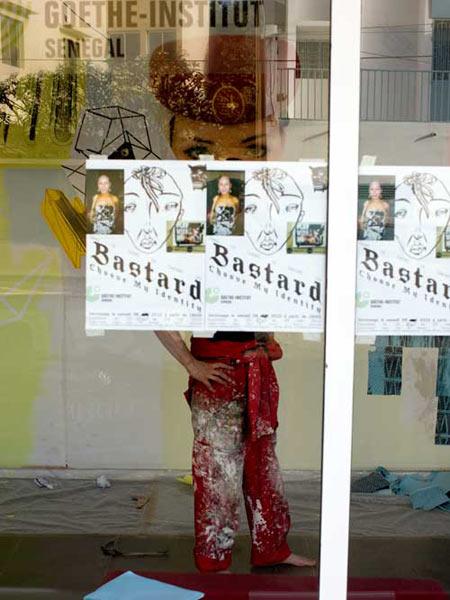
Continue reading "Impressions from Dakar"
Comments (4)
03/05/2010
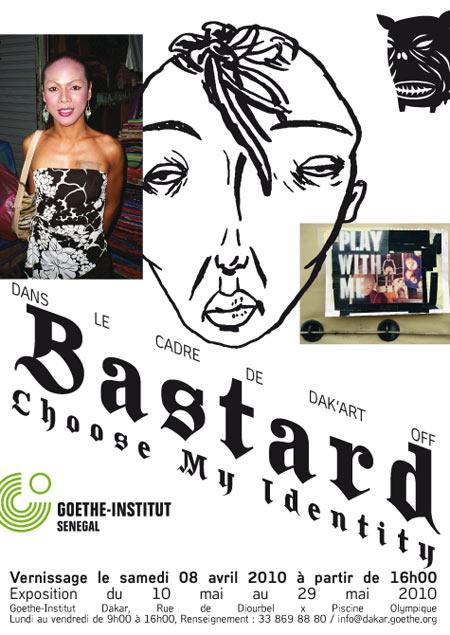
After a long break we´re on the road again. The Goethe-Institut Dakar in Senegal invited us to work there and present our work. The exposition takes place during the Dak´Art.
Continue reading "DakArt Off: „Bastard - Choose my identity“"
Comments (0)
05/03/2009
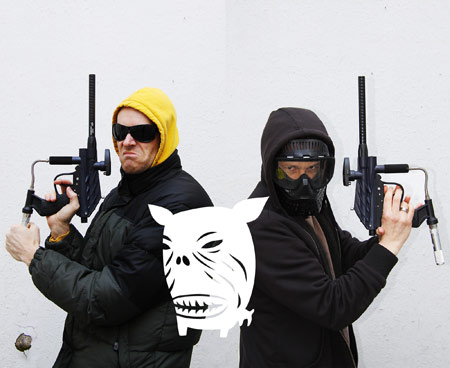
CHARACTER SHOOTING GALLERY
Der Character Rummelplatz ist eröffnet. Das Bastard-Project läd zur shooting gallery. Eine
kleine Horde jungfräulich weißer Charakters wartet sehnsüchtig auf ihre Initiation. Spürt die
Energie des surreal farbenfrohen Rituals und werdet Teil der Paintball Finissage
http://pictopia.festival.pictoplasma.com/
Continue reading "Erectile - the new Bastard Project"
Comments (6)
11/04/2008

Art Bastard, brothers in name, are a new plattform for urban, contemporary art & culture, presenting a selection of artists from all over the world. The site lead their readers to events, galleries and present all kind of brilliant researched informations about and around art.
They present our book and made a nice portrait of sunny andré.
Comments (0)
14/02/2008
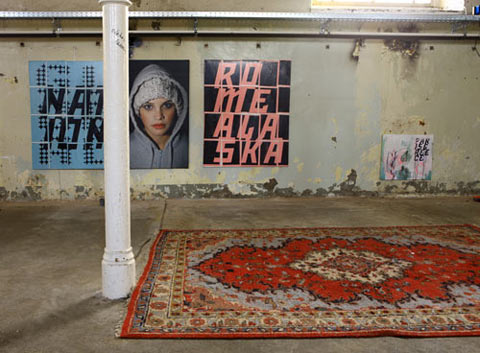
As usual: once the party is over you feel so tired. But happy, because it was nice to see all those people. Here a fiew images showing the typo-work of this event. More images to follow soon.
Continue reading "Typo-images of the Exposition"
Comments (0)
22/01/2008
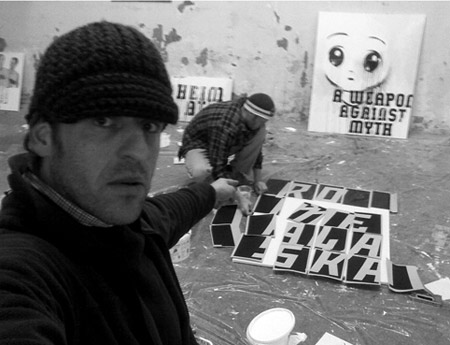
Bastard photographer Christian is proud of his new phone, making pictures from everything and everywhere. Catch a glimpse of the preparation for our exposition and party...See you in two days!
Comments (1)
14/12/2007
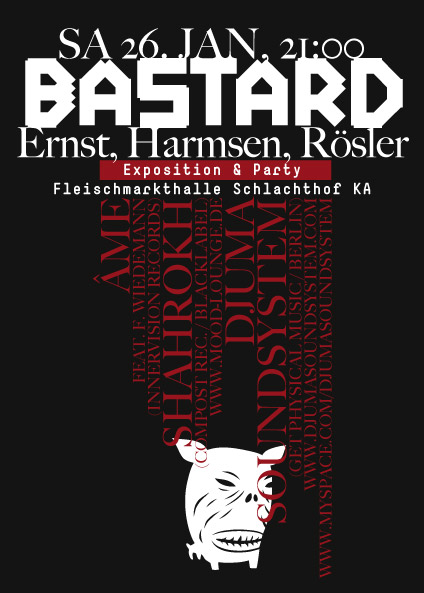
THE BASTARD EXHIBITION AND PARTY
DO 24. Jan 2008, 18:00
VIP OPENING EVENT: only for special guests
SA 26. Jan 2008, 21:00 PARTY
Âme / feat. F. Wiedemann (Innervision Records)
Shahrokh (Compost Records / Blacklabel)
Djuma soundsystem (Get Physical Music / Berlin)
10,- € / students 8,- €
SUN 27. Jan 2008, 15:00-18:00
Finissage with Glühwein
Fleischmarkthalle Schlachthof Karlsruhe, Durlacher Allee 62
This Event is proudly supported by: PTV AG and Finest/Magma BRAND DESIGN
Comments (0)
06/12/2007
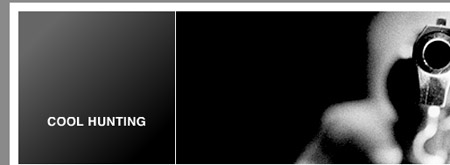
Leonora Oppenheim once worked in Barcelona, now she is back in London. We met here during our exposition last year in Barcelona at the Ras Gallery (she helped us to set up the exposition). Now she writes for Cool Hunting. Thanx for presenting André´s work in Paris!
Comments (0)
03/12/2007

André is not getting tired of travelling around the world and painting walls in galleries. Just one week after Dortmund he rushed to Paris for an exhibition with Illustrative Paris from 29.11. - 9.12.2007 in Espace Commines, 17 rue Commines, 75003 Paris
Mehr Infos hier
Continue reading "André goes Paris"
Comments (0)
26/11/2007
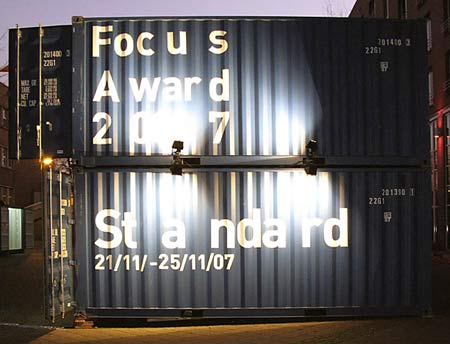
We just came back from our weekend in Dortmund where we presented our work during the FOCUS AWARD (See also Slanted).
The students of the Design School Dortmund made a great job. Excellent organisation, perfect accomodation, interesting line-up, great audience, good vibes. The blue containers where amazing! We loved the typographic work on the posters and catalogues. Thank you!
Continue reading "Impressions from Focus Award"
Comments (6)
23/11/2007
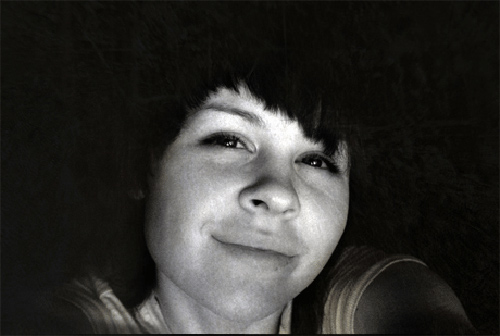
We just got thes images from Maria, born in Novokorsunskoj / Titnascherski. 2006 she won the epson artphoto contest and 2007 the large price of student spring at the kuban. She will work on the krasnodar student project with Bastard-fotograf Ch. Ernst.
Continue reading "Maria Guseva"
Comments (4)
19/11/2007
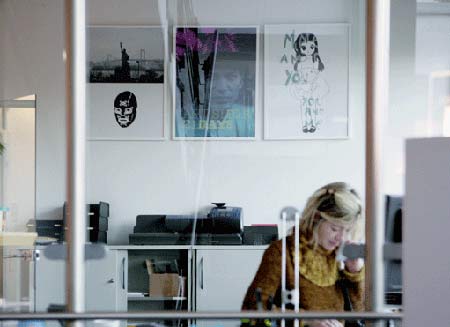
From 15 of November till beginning of next year a part of the work of Bastard-Project is shown in the main building of PTV AG in Karslruhe, Stumpfstr. 1
This is part of a pre-show. The main exposition (beeing announced soon) will open on 24th and 26th of January 2008 in the old slaughterhouse of Karlsruhe (a beautiful place that has been changed to a music/exposition space during the last few weeks).
Continue reading "BASTARD goes PTV AG"
Comments (1)
19/11/2007
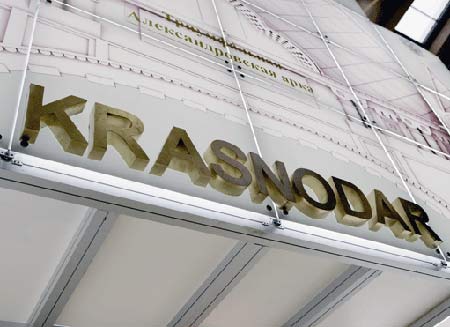
A couple of days ago Bastard Photograph Ch. Ernst Kurti came back from Offerta (a local Fair about products of the region) with a bunch of pictures taken at the both of Krasnodar (the twin-city of Karlsruhe). In 2008 he would like to invite a few students to come here and work with him, in return he will visit Krasondar and give lectures at the Art School. Nice new project.
Continue reading "Chrisitan Ernst goes Krasnodar"
Comments (0)
15/11/2007

We are invited to present our Work during the FOCUS AWARD in Dortmund. Our lecture is at 18:30. A lot of great Speakers will be there. See the listing here.
Comments (0)
11/07/2007
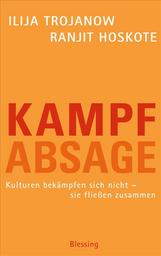
Bastard author Ilija Trojanow wrote a new book subtitled Kulturen bekämpfen sich nicht, sie fließen zusammen: Cultures don´t fight each other, they melt together.
Ranjit writes for The Bombay Times and The Hindu. He is poet and secretary of the indian PEN.
Continue reading "Kampfabsage"
Comments (1)
01/06/2007
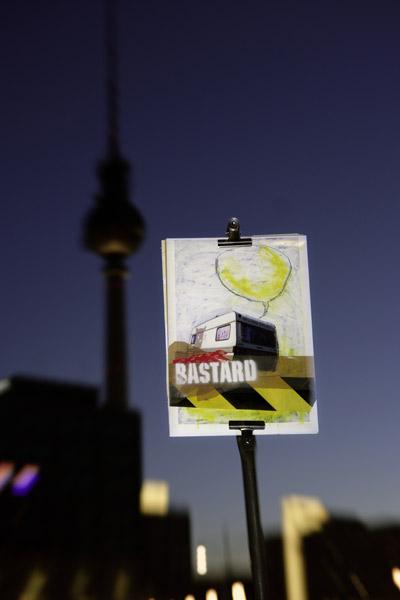
Time is running. We will try to upload a bunch of images from our road-trip to berlin in the upcoming days.
We drove up to Berlin with our caravan tuesday 15 th of mai, arrived at typoBerlin on thursday and stayed till sunday. Our lecture on friday showed images we took on our way to Berlin, a kind of experimental road show. On stage where also DJ Frank Wiedemann (Âme) and Sudabeh Mohafez.
Continue reading "Typo Berlin, 18-20th of May"
Comments (0)
01/06/2007
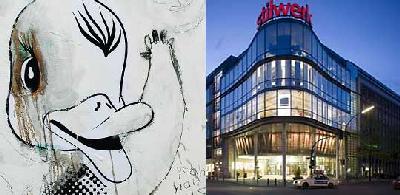
The Exposition "Die Künstler der Illustrative" will show works from: Mario Wagner (D), Rusell Cobb (UK), Lars Henkel (D), Vania Zouravlev (RU), Andre Rösler (D), Pierre Le Gonidec (F), Tim Dinter (D), Louise Weir (UK), David Foldvari (UK), Jan Feindt (D), Roman Bittner (D), Finn Campbell-Notman (UK).
location: Designcenter Stilwerk, Kantstr. 17, 10623 Berlin
Open: 1.- 30. June 2007, every day from 9:00 - 20.00
Opening: 8. June 2007, 19.00
Comments (0)
07/05/2007
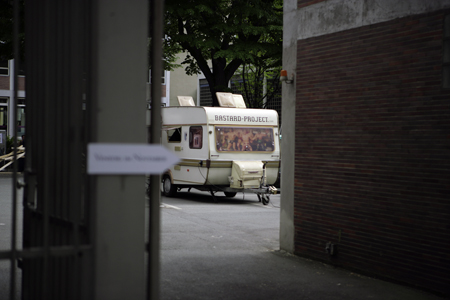
It was absolutely great to be there. The folks from FH-Mainz made a great job: perfectly organised, fantastic party location, brilliant speakers... our lecture seemed to be one of the highlights.
More pix also on our flickr space.
See also tdc/slanted.
see you in berlin!
Continue reading "translations 02"
Comments (6)
26/04/2007

We will be in Berlin at Typo Berlin, presenting the Slanted Magazine (Issue #4 Grid/Matrix), our Instant-Gallery Caravan (just in front of the bcc Berliner Congress Center, Alexanderstr. 11) with a live performance and show on friday in the TYPOshow Auditorium. See you!
Freitag | 16:00 Uhr | TYPOshow
Instant Gallery on Tour
Ein Bastard Project, mit Lesung der Autorin Sudabeh Mohafez und aktuellen Arbeiten des Bastard-Projects von dem Fotografen Christian Ernst, dem Illustrator André Rösler und dem Designer Lars Harmsen. DJ Frank Wiedemann / Âme (Sonar Kollektiv) tritt live auf. Seit Februar 2007 sind die Autoren des Bastard Buches immer wieder on Tour, diesmal mit einem Wohnwagen welcher zu einer Galerie umgewandelt wurde. Auf dem Weg zur TYPO wurde auf zahlreichen Stationen Bilder von Menschen und Orten eingefangen und in einer Instant-Gallery präsentiert. Der Wohnwagen wird während der TYPO vor Ort sein.
Samstag | 15:00 Uhr | TYPOshow
Typografie, Magazine & Playlists
Magazine und deren Designs folgen bestimmten modischen Codes. Die visuellen Moden können sicherlich mit den musikalischen Moden der letzten Jahre verglichen werden. Die meisten Grafik- und auch Typedesigner verorten sich ja mit ihrer Arbeit und ihrem Musikgeschmack in den verschiedenen zeitgenössischen Feldern – Typografie, Magazine, Playlists.
Comments (0)

BY: Christian Ernst, Lars Harmsen,
André Rösler, Ulrich Weiss
AUTHORS: László Csiba, Radek Knapp,
Sudabeh Mohafez, José F.A. Oliver,
Selim Özdogan, Ilija Marinow Trojanow.
396 pages, full colour, hardcover
195 x 235 mm
CDR with 50 Fonts free for layout,
50 HighRes Pix, bonus music tracks
Price: 35 Euro
ISBN: 84-96540-15-4
If you are interested in supporting this international project, feel free to join us!
| Sun | Mon | Tue | Wed | Thu | Fri | Sat |
|---|---|---|---|---|---|---|
| 1 | ||||||
| 2 | 3 | 4 | 5 | 6 | 7 | 8 |
| 9 | 10 | 11 | 12 | 13 | 14 | 15 |
| 16 | 17 | 18 | 19 | 20 | 21 | 22 |
| 23 | 24 | 25 | 26 | 27 | 28 | 29 |
| 30 |